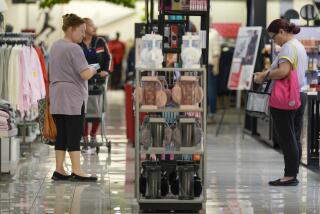Consumer Spending Surges 1.1% in April : Biggest Rise Since June; Personal Income Up .4%
- Share via
WASHINGTON — Americans thronged back to stores in April, pushing consumer spending up 1.1%, the biggest advance in nearly a year, the government reported today. The figure far outpaced a 0.4% increase in personal income.
The combination of a strong spending increase and the sluggish income gain produced a sharp reduction in the personal savings rate, which dropped to 5.3% last month from a three-year high of 6.3% in March, the Commerce Department said.
The April increase in personal income was the smallest gain since income fell 0.2% in November. Personal income had risen a strong 0.8% in March and 1% in February.
Inflated March Figures
Last month’s increase in personal income would have been stronger were it not for decreases in farm subsidies over the last two months, coupled with bonuses for auto workers and retroactive Social Security benefit payments that inflated March’s figure.
Excluding those special factors, personal income advanced a strong 0.8% in April after rising 0.7% in March.
The 1.1% increase in personal consumer expenditures, to a seasonally adjusted annual rate of $3.42 trillion, was the biggest advance since a 1.3% increase was registered last June.
Expenditures had risen just 0.3% in March and 0.4% in February, causing analysts to attribute part of the current slowdown in economic growth to slackening consumer spending.
Consumer spending is closely watched as an indicator of the economy’s health because it accounts for two-thirds of overall economic activity.
The rebound in spending last month was partly attributed to a rise in auto sales, which perked up somewhat in April after car makers launched a new round of rebates and cut-rate financing deals to lure customers back to showrooms.
The pickup in auto sales was the primary power behind a 3.2% increase last month in consumer spending on durable goods--”big ticket” items expected to last at least three years.
Spending on durable goods last month rose to a seasonally adjusted annual rate of $467.1 trillion after declining during the previous two months, when auto sales had been weak.
Purchases of non-durable goods, meanwhile, rose 0.7% last month and spending on services rose 0.8%.
Disposable, or after-tax, income held virtually even last month after rising 0.3% in March. After-tax income was held down by a higher-than-usual April surge in federal income tax payments that was partly attributed to the aftereffects of the 1986 tax overhaul.
More to Read
Inside the business of entertainment
The Wide Shot brings you news, analysis and insights on everything from streaming wars to production — and what it all means for the future.
You may occasionally receive promotional content from the Los Angeles Times.










